The Hague (Dutch: Den Haag or 's-Gravenhage) is a city in the province of South Holland in the Netherlands. It is the seat of the Dutch parliament and government, and the residence of King Willem-Alexander. It is not the capital city, which is Amsterdam. The municipality (which is the city) has more than 525,000 inhabitants, it is the third largest city of the Netherlands. Since January 1, 2015 The Hague and its suburbs are part of the Rotterdam-The Hague Metropolitan Region.
The Hague lies on the North Sea and is home to Scheveningen, the most popular seaside resort of the Netherlands. Also the smaller resort of Kijkduin is part of the city.
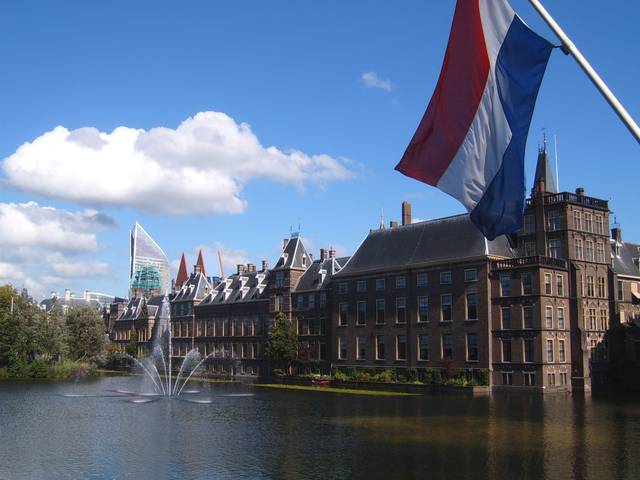 Internationally, The Hague is often known as the "judicial capital of the world" due to the many international courts that are located in the city. Among these are the International Court of Justice, the International Criminal Tribunal for the former Yugoslavia and, since 2004, the International Criminal Court. Beside these institutions, The Hague is home to more than 150 international organizations, and to many EU institutions, multinational companies and embassies. This gave the city a distinct international character — one that is noticeably different from Amsterdam. Rather than having the many foreign tourists and fortune-seekers attracted by Amsterdam's reputation for excitement and liberalism, The Hague generally has more expatriates working and living in the city because of the number of international institutions and companies. Because of this, The Hague has a reputation as a wealthy, conservative and somewhat sedate city.
Internationally, The Hague is often known as the "judicial capital of the world" due to the many international courts that are located in the city. Among these are the International Court of Justice, the International Criminal Tribunal for the former Yugoslavia and, since 2004, the International Criminal Court. Beside these institutions, The Hague is home to more than 150 international organizations, and to many EU institutions, multinational companies and embassies. This gave the city a distinct international character — one that is noticeably different from Amsterdam. Rather than having the many foreign tourists and fortune-seekers attracted by Amsterdam's reputation for excitement and liberalism, The Hague generally has more expatriates working and living in the city because of the number of international institutions and companies. Because of this, The Hague has a reputation as a wealthy, conservative and somewhat sedate city.
The Hague has very little of the edginess and excitement of Amsterdam; however, it provides well for its inhabitants in different ways, such as large areas of green space, 11 km of coastline, attractive shopping streets and an extensive multicultural scene. Rather than having canals like other Dutch cities, The Hague has streets and avenues that are just a little bit wider than those in the rest of the country, giving the city a more continental feel. Instead of the typical Dutch renaissance 17th-century step-gabled houses, it has 18th-century mansions in baroque and classicist styles. The city is considered by many as the most stately of the country. Just outside the city centre, posh neighbourhoods effuse a more 19th century look with eclectic and art nouveau architecture.
The farther you get from the sea front and the city centre, however, the more neighbourhoods tend to become less well-off. One dividing line between affluent and sketchier areas is drawn by some at Laan van Meerdervoort, which runs parallel to the seaside. Areas away from the sea tend to have much less in the way of green space. An exception to this is one centrally located park, Zuiderpark, which also used to contain the stadium of the local football team ADO Den Haag. Some of its supporters were known as the most notorious hooligans of the country, perpetuating a stereotype of "lower-class" for the inhabitants of that area.
The Hague offers great architecture, from the picturesque government complex of the Binnenhof, to the grand and stately mansions on Lange Voorhout. Museums like the Mauritshuis rank among the best in the country. For food aficionados, The Hague offers some of the country's best Indonesian cuisine, due to large-scale immigration from this former Dutch colony. The city also offers good opportunities for outings, such as extensive green spaces for walking and bicycling as well as dunes and seaside recreation areas just a few tram stops away from the city centre. The Hague also offers a few attractions especially appealing to children, such as the miniature city of Madurodam and the 360 degree Omniversum cinema.
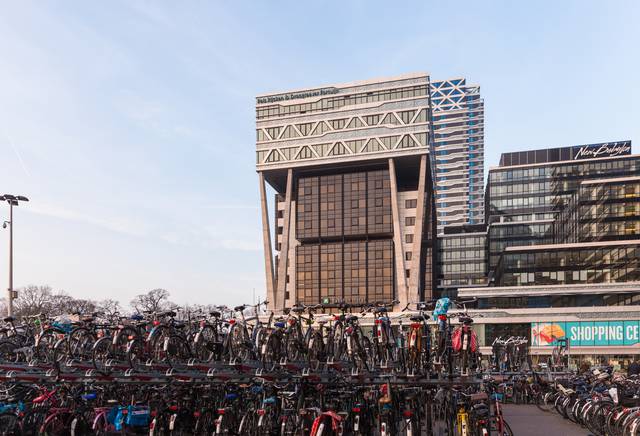 Over recent decades, the city has undergone an extensive amount of development in the form of modern architecture projects. Recent constructions include the City Hall and Central Library by American architect Richard Meier, De "Snoeptrommel" (known by the locals as Candy-Box) - a round shopping centre next to the old town hall, and a collection of post-modern, brick-clad office towers in between the city hall and the Centraal railway station, which provide new housing for a number of ministries. A major infrastructural development has been the construction of an underground tram tunnel underneath Grote Marktstraat, which is used by regular trams, and a new light-rail system, known as RandstadRail, linking The Hague with the neighbouring cities of Zoetermeer and Rotterdam.
Over recent decades, the city has undergone an extensive amount of development in the form of modern architecture projects. Recent constructions include the City Hall and Central Library by American architect Richard Meier, De "Snoeptrommel" (known by the locals as Candy-Box) - a round shopping centre next to the old town hall, and a collection of post-modern, brick-clad office towers in between the city hall and the Centraal railway station, which provide new housing for a number of ministries. A major infrastructural development has been the construction of an underground tram tunnel underneath Grote Marktstraat, which is used by regular trams, and a new light-rail system, known as RandstadRail, linking The Hague with the neighbouring cities of Zoetermeer and Rotterdam.
A major redevelopment project is underway in the area around the Centraal railway station. Here, skyscrapers like the 142 m Hoftoren rise up over the city and several other high-rise towers are under construction.
- VVV Den Haag, Spui 68 (Located at the Central Library, next to the town hall. Mo 12:00-20:00, Tu-Fr 10:00-20:00, Sa 10:00-17:00, Su 10:00-17:00.
- City Mondial, Wagenstraat 193. Tu-Fr 09:30-17:00, Sa 10:00-17:00, Su 10:00-14:30. Their website is in Dutch language only.
VVV Den Haag, Spui 68 (Located at the Central Library, next to the town hall. Mo 12:00-20:00, Tu-Fr 10:00-20:00, Sa 10:00-17:00, Su 10:00-17:00.
City Mondial, Wagenstraat 193. Tu-Fr 09:30-17:00, Sa 10:00-17:00, Su 10:00-14:30. Their website is in Dutch language only.
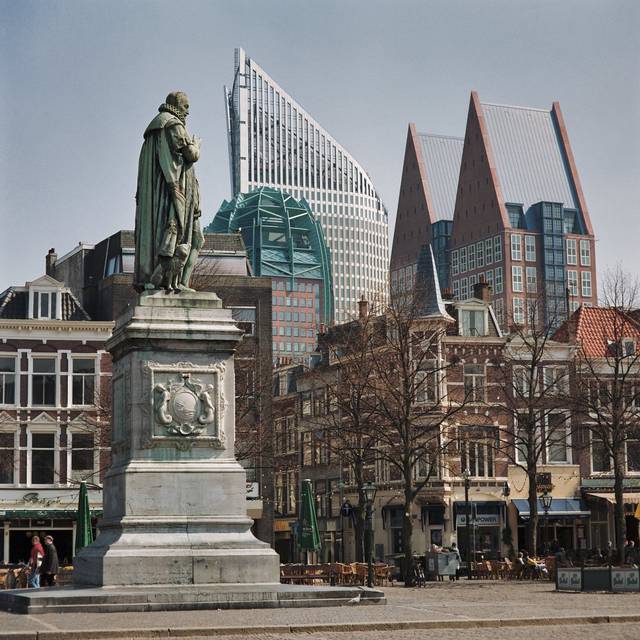 The heart of the city contains most of the historic architecture from the medieval, renaissance, and Baroque periods and is easily accessible on foot. You'll also find lots of outdoor cafes and shopping near the Plein on the Lange Poten or just east of there on the Hofweg.
The heart of the city contains most of the historic architecture from the medieval, renaissance, and Baroque periods and is easily accessible on foot. You'll also find lots of outdoor cafes and shopping near the Plein on the Lange Poten or just east of there on the Hofweg.
- Plein. This square — Plein simply translates as 'square' in English — is one of the most elegant in the centre. Located right next to the Binnenhof, it is lined with historic government buildings on three of its four sides. The north side is lined with bars and cafés, which spill out onto the square in summer. These sidewalk cafés are quite popular with politicians from the neighbouring Binnenhof, and even Prime Minister Mark Rutte can be spotted here with a pint regularly. The square is also the scene for demonstrations against government policies. The statue in the middle is that of William of Orange, heralded as the founding father of the Dutch nation.
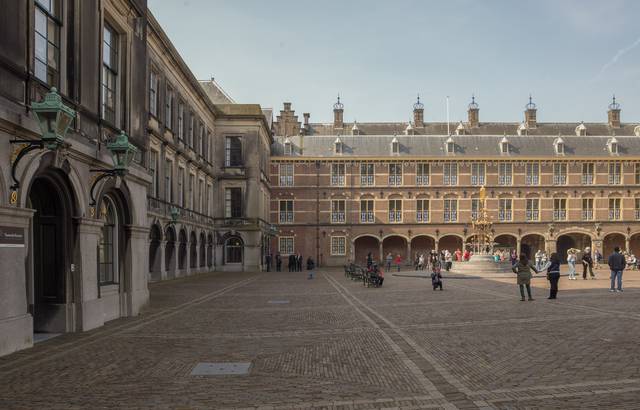
- Binnenhof, +31 70 7570200. M-Sa 10AM-4PM; guided tours only (in Dutch +audio guides on some other languiges). The Binnenhof (Inner Court) is a castle built in the 13th century as residence of the count of Holland. Ever since, it has almost subsequently been the seat of the government of Holland, and later all of the Netherlands. It used to be surrounded by moats on all sides. Since then it has been modified countless times to accommodate the expanding Dutch government. The moats have been filled, but the castle still borders on a pond (the Hofvijver, Court Pond). In its waters the old buildings continue to mirror themselves. Today, the Binnenhof houses the two chambers of the Dutch parliament and the Prime Minister's office in a small round tower opposite the Mauritshuis. Enter through one of the gates on Plein or Buitenhof and you will find yourself in a medieval enclosed courtyard, surrounded by architecture from the 13th up to the 19th century. There may be crowds gathered here on occasion because of public demonstrations, TV airings or receptions for foreign officials. In the centre stands the Ridderzaal (Knight's Hall), the centrepiece of the castle, today used for ceremonial purposes. Unfortunately, the other splendid rooms of the complex are closed to the general public. It is possible, however, to attend the meetings of the parliament. The House of Representatives of the parliament meets every Tuesday, Wednesday and Thursday, in a modern chamber from 1992. The Senate meets on a weekly basis, on Tuesdays, and does so in a splendid 17th century Dutch-styled chamber with a lavishly painted ceiling. €5-€10 (see online reservation for tours and prices).
- Mauritshuis, Plein 29 (next to the Binnenhof. M-S 10AM-6PM, Th 10AM-8PM, and also M 10AM-5PM from Apr-Aug.. Housed in a 17th-century palace overlooking the water of the Hofvijver pond, the Royal Picture Gallery Mauritshuis contains the former collection of last Dutch stadtholder, William the V. While the museum is quite small (a complete tour takes a little over an hour) it contains some of the most famous work from the old Dutch Masters, including Johannes Vermeer (Girl with a Pearl Earring and View of Delft), Rembrandt van Rijn (The Anatomy Lesson of Dr. Nicolaes Tulp), Andy Warhol ("Queen Beatrix"), Rembrandt self-portraits at ages 20 and 63, and others. It is well worth a visit, especially as it has just been renovated. Adult €14, under 18 get in free.
- Galerij Prins Willem V, Buitenhof 33. Tu-Su 12am-5pm. This gallery essentially is a part of Mauritshuis. A collection of 18th century paintings from the Mauritshuis is on display there. €5; combined ticket with Mauritshuis €17,50.
- Gevangenpoort, Buitenhof 33, +31 70 3460861. T-F 10AM-5PM, Sa-Su 12PM-5PM. Built in 1370 as an entrance gate to the Binnenhof complex, the Gevangenpoort (Prison Gate) was converted into a prison in 1420. In 1853 the prison shutdown and it was turned into a museum. For a taste of medieval justice, have a look at their collection of torture instruments and get locked inside an original medieval cell block. € 7,50; + Galerij Prins Willem V € 10,00.
- Bredius Museum, Lange Vijverberg 14, +31 70 3620729. T-Su 11AM-5PM. The private collection of Abraham Bredius, a 19th-century art historian contains Dutch Baroque art, as well as drawings, porcelain and crafted silver. €4.50.
- Lange Voorhout. This former extension of The Hague Forest is now a large tree-lined square, bordered on all sides by grand 18th century townhouses. The large Baroque building on the west side is the 'Huis Huguetan', home to the Dutch supreme court. The square is especially pretty in spring, when its crocuses are in bloom. On Thursdays and Sundays there is a very good antique and book market. Every summer, the square hosts Den Haag Sculptuur (The Hague Sculpture), a free outdoor sculpture exhibition. The fortified building on the corner is the US Embassy and has been a point of contention among locals and embassy officials because of the heightened security.
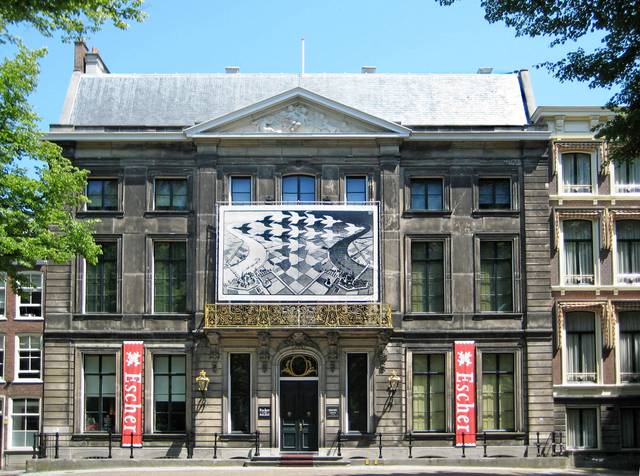
- Escher in Het Paleis, Lange Voorhout 74 (trams 16, 17 (Korte Voorhout stop), +31 70 4277730. T-Su 11AM-5PM. This former royal palace was converted in 2002 into a museum dedicated to the famous Dutch graphic artist M.C. Escher. The first two floors display prints, sketches and archive material showing how Escher progressed from realistic pictures to his later works of optical illusion and geometrical pattern. The top floor offers a trip through Escher's worlds with interactive screens and games and a special Escher Room. There are also scavenger hunts for younger children. On Sunday and during the school holidays, there are workshops for children. €9.50.
- Grote Kerk. Now a meetings venue.
- Oude Stadhuis. The original town hall is a small building from the 15th century when The Hague itself was a small settlement around the Royal Court. In the 18th century it was expanded upon and now has a grand façade facing the 15th-century Grote Kerk (Big Church), originally used as city's main place of worship, but now primarily functions as an exhibition space.
- Stadhuis. In the early 1990s, the municipality moved to this enormous white building by American architect Richard Meier, nicknamed by locals as the Ice Palace. Walk in to have a look at the lofty main hall, which has exhibits on various topics related to the city. The two air bridges through the hall connecting the various offices had to be fenced off to prevent suicides, but still make for a nice view of the atrium below. The city hall borders a large, somewhat barren modern square with a fountain. It contrasts sharply with the Baroque Nieuwe Kerk (New Church), located in a small park in the other side of the road.
- Denneweg. This street is a prime area for finding antique and specialty shops. It also has some good pubs and upscale restaurants to recharge in after shopping. Parallel to the Denneweg run the Hooigracht and Smidswater canals, which are two of the very few canals in The Hague compared to other major Dutch cities and towns.
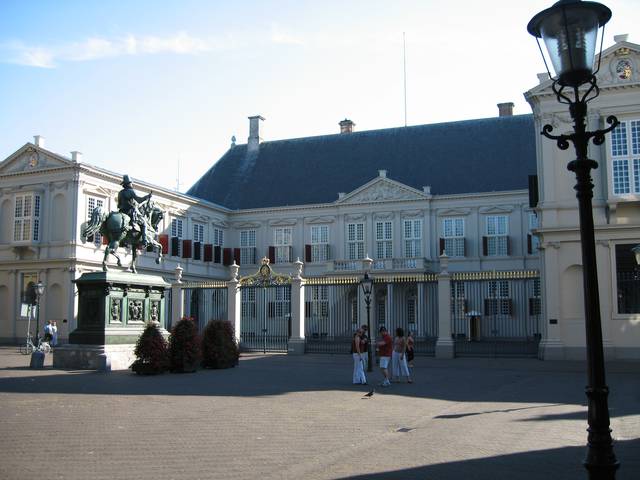
- Paleis Noordeinde. This is the royal palace that King Willem-Alexander uses as his office. While the inside is not open to the public, the 17th-century façade can be seen from Noordeinde street, which also has a large number of art galleries. The gardens on the opposite side of the palace are accessible to the public for walking.
Plein. This square — Plein simply translates as 'square' in English — is one of the most elegant in the centre. Located right next to the Binnenhof, it is lined with historic government buildings on three of its four sides. The north side is lined with bars and cafés, which spill out onto the square in summer. These sidewalk cafés are quite popular with politicians from the neighbouring Binnenhof, and even Prime Minister Mark Rutte can be spotted here with a pint regularly. The square is also the scene for demonstrations against government policies. The statue in the middle is that of William of Orange, heralded as the founding father of the Dutch nation.
Binnenhof, +31 70 7570200. M-Sa 10AM-4PM; guided tours only (in Dutch +audio guides on some other languiges). The Binnenhof (Inner Court) is a castle built in the 13th century as residence of the count of Holland. Ever since, it has almost subsequently been the seat of the government of Holland, and later all of the Netherlands. It used to be surrounded by moats on all sides. Since then it has been modified countless times to accommodate the expanding Dutch government. The moats have been filled, but the castle still borders on a pond (the Hofvijver, Court Pond). In its waters the old buildings continue to mirror themselves. Today, the Binnenhof houses the two chambers of the Dutch parliament and the Prime Minister's office in a small round tower opposite the Mauritshuis. Enter through one of the gates on Plein or Buitenhof and you will find yourself in a medieval enclosed courtyard, surrounded by architecture from the 13th up to the 19th century. There may be crowds gathered here on occasion because of public demonstrations, TV airings or receptions for foreign officials. In the centre stands the Ridderzaal (Knight's Hall), the centrepiece of the castle, today used for ceremonial purposes. Unfortunately, the other splendid rooms of the complex are closed to the general public. It is possible, however, to attend the meetings of the parliament. The House of Representatives of the parliament meets every Tuesday, Wednesday and Thursday, in a modern chamber from 1992. The Senate meets on a weekly basis, on Tuesdays, and does so in a splendid 17th century Dutch-styled chamber with a lavishly painted ceiling. €5-€10 (see online reservation for tours and prices).
Mauritshuis, Plein 29 (next to the Binnenhof. M-S 10AM-6PM, Th 10AM-8PM, and also M 10AM-5PM from Apr-Aug.. Housed in a 17th-century palace overlooking the water of the Hofvijver pond, the Royal Picture Gallery Mauritshuis contains the former collection of last Dutch stadtholder, William the V. While the museum is quite small (a complete tour takes a little over an hour) it contains some of the most famous work from the old Dutch Masters, including Johannes Vermeer (Girl with a Pearl Earring and View of Delft), Rembrandt van Rijn (The Anatomy Lesson of Dr. Nicolaes Tulp), Andy Warhol ("Queen Beatrix"), Rembrandt self-portraits at ages 20 and 63, and others. It is well worth a visit, especially as it has just been renovated. Adult €14, under 18 get in free.
Galerij Prins Willem V, Buitenhof 33. Tu-Su 12am-5pm. This gallery essentially is a part of Mauritshuis. A collection of 18th century paintings from the Mauritshuis is on display there. €5; combined ticket with Mauritshuis €17,50.
Gevangenpoort, Buitenhof 33, +31 70 3460861. T-F 10AM-5PM, Sa-Su 12PM-5PM. Built in 1370 as an entrance gate to the Binnenhof complex, the Gevangenpoort (Prison Gate) was converted into a prison in 1420. In 1853 the prison shutdown and it was turned into a museum. For a taste of medieval justice, have a look at their collection of torture instruments and get locked inside an original medieval cell block. € 7,50; + Galerij Prins Willem V € 10,00.
Bredius Museum, Lange Vijverberg 14, +31 70 3620729. T-Su 11AM-5PM. The private collection of Abraham Bredius, a 19th-century art historian contains Dutch Baroque art, as well as drawings, porcelain and crafted silver. €4.50.
Lange Voorhout. This former extension of The Hague Forest is now a large tree-lined square, bordered on all sides by grand 18th century townhouses. The large Baroque building on the west side is the 'Huis Huguetan', home to the Dutch supreme court. The square is especially pretty in spring, when its crocuses are in bloom. On Thursdays and Sundays there is a very good antique and book market. Every summer, the square hosts Den Haag Sculptuur (The Hague Sculpture), a free outdoor sculpture exhibition. The fortified building on the corner is the US Embassy and has been a point of contention among locals and embassy officials because of the heightened security.
Escher in Het Paleis, Lange Voorhout 74 (trams 16, 17 (Korte Voorhout stop), +31 70 4277730. T-Su 11AM-5PM. This former royal palace was converted in 2002 into a museum dedicated to the famous Dutch graphic artist M.C. Escher. The first two floors display prints, sketches and archive material showing how Escher progressed from realistic pictures to his later works of optical illusion and geometrical pattern. The top floor offers a trip through Escher's worlds with interactive screens and games and a special Escher Room. There are also scavenger hunts for younger children. On Sunday and during the school holidays, there are workshops for children. €9.50.
Grote Kerk. Now a meetings venue.
Oude Stadhuis. The original town hall is a small building from the 15th century when The Hague itself was a small settlement around the Royal Court. In the 18th century it was expanded upon and now has a grand façade facing the 15th-century Grote Kerk (Big Church), originally used as city's main place of worship, but now primarily functions as an exhibition space.
Stadhuis. In the early 1990s, the municipality moved to this enormous white building by American architect Richard Meier, nicknamed by locals as the Ice Palace. Walk in to have a look at the lofty main hall, which has exhibits on various topics related to the city. The two air bridges through the hall connecting the various offices had to be fenced off to prevent suicides, but still make for a nice view of the atrium below. The city hall borders a large, somewhat barren modern square with a fountain. It contrasts sharply with the Baroque Nieuwe Kerk (New Church), located in a small park in the other side of the road.
Denneweg. This street is a prime area for finding antique and specialty shops. It also has some good pubs and upscale restaurants to recharge in after shopping. Parallel to the Denneweg run the Hooigracht and Smidswater canals, which are two of the very few canals in The Hague compared to other major Dutch cities and towns.
Paleis Noordeinde. This is the royal palace that King Willem-Alexander uses as his office. While the inside is not open to the public, the 17th-century façade can be seen from Noordeinde street, which also has a large number of art galleries. The gardens on the opposite side of the palace are accessible to the public for walking.
- Panorama Mesdag, Zeestraat 65, +31 70 310 66 65. M-F 10AM-5PM, Sa-Su 12PM-5PM. The Panorama Mesdag is a cylindrical painting from 1881, more than 14 m high and 120 m in circumference. One of the most famous painters of The Hague School, Hendrik Willem Mesdag, created a vista of the sea, the dunes and Scheveningen village. It is the oldest 19th-century panorama in the world that's still in its original site. €10; Children (4-11 years) €5; for combined tickets consult with the web site.
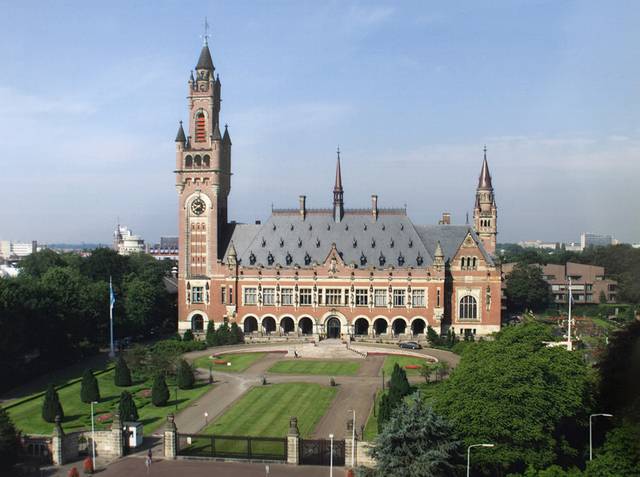
- Vredespaleis, Carnegieplein 2 (bus 24 (Kijkduin stop), tram 1 (to Scheveningen Noorderstand), +31 70 3024137. The Peace Palace was built in 1913, to house the Permanent Court of Arbitration, which was hoped to provide a means to legally settle international disputes. Ironically, World War I broke out just a year later. Today the Peace Palace also houses the International Court of Justice, the principal judicial body of the UN, which settles disputes between countries only. The building can only be visited with a guided tour, available only on certain weekends. Check the right-hand column of the website for open days. 8.50€.
- De Verdieping van Nederland. W-Sa 9AM-5PM, T 9AM-8PM, Su-M 12PM-5PM. A free exhibition showcasing the history of the Netherlands through original copies of historically significant documents. It has the original copy of peace treaty of Münster with Spain, marking the end of the 80-year Dutch independence war in 1648, and the original sales act of the Dutch purchase of Manhattan from the Indians.
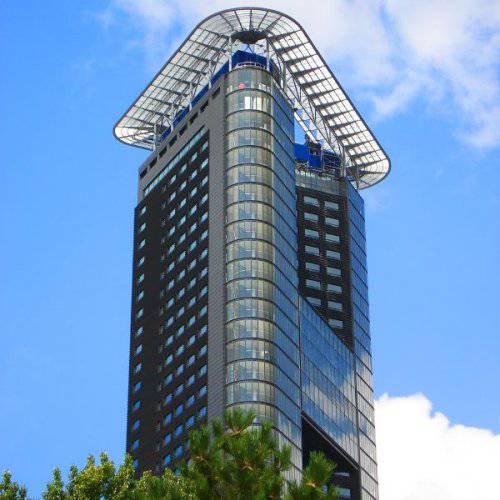
- Haagse Toren, Rijswijkseplein 786 (next to Den Haag HS train station, alight at "Station Hollands Spoor" tram stops, +31 70 305-1000. open 10AM-10PM daily (cafe and restaurant opening times vary). The tallest apartment tower in The Hague, nicknamed "the flatiron" in Dutch for its elongated triangular shape, has a viewing platform, café, bar and restaurant at the top. A drink is included in the ticket for the elevator that takes you to the top two floors, alternatively you can opt for a lunch, dinner or Highest Tea at the restaurant. The views are indeed impressive, especially at good weather and at sunset, as The Hague does not have many tall buildings to obscure them. adults €9, reduced €4.5(?) (children, students, 65+).
- Paleis Huis ten Bosch. It is one of three official residences of the Dutch Royal Family. While the surrounding park is open, the palace itself is not open to visitors.
- Louwman Museum, Leidsestraatweg 57 (Between benoordenhoutseweg and N44/A44, +31 70 304-7373. Daily, except Mondays, from 10AM-5PM. Opened in juli 2010. This private collection contains a century of history of the car. Price: € 13,50, 6-12 year € 7,50, Parking € 5,-..
- Haags Openbaar Vervoer Museum, Parallelweg 224, Schilderswijk (corner of Parallelweg and Ter Borchstraat, opposite tram stop Wouwermanstraat, two stops from Hollands Spoor, tram 9, 11, 12, 16, 31, +31 70 4451559. open Sundays Apr-Oct 12:30 to 17:00. History of public transit in The Hague with exhibits of old trams and buses. Also 90-minute rides are available at 13:30 and 15:00 from the museum using an old tram or bus. Free museum admittance but tram/bus rides cost €6 (adult) or €4 (child/senior).
Panorama Mesdag, Zeestraat 65, +31 70 310 66 65. M-F 10AM-5PM, Sa-Su 12PM-5PM. The Panorama Mesdag is a cylindrical painting from 1881, more than 14 m high and 120 m in circumference. One of the most famous painters of The Hague School, Hendrik Willem Mesdag, created a vista of the sea, the dunes and [[Scheveningen]] village. It is the oldest 19th-century panorama in the world that's still in its original site. €10; Children (4-11 years) €5; for combined tickets consult with the web site.
Vredespaleis, Carnegieplein 2 (bus 24 (Kijkduin stop), tram 1 (to Scheveningen Noorderstand), +31 70 3024137. The Peace Palace was built in 1913, to house the Permanent Court of Arbitration, which was hoped to provide a means to legally settle international disputes. Ironically, World War I broke out just a year later. Today the Peace Palace also houses the International Court of Justice, the principal judicial body of the UN, which settles disputes between countries only. The building can only be visited with a guided tour, available only on certain weekends. Check the right-hand column of the website for open days. 8.50€.
De Verdieping van Nederland. W-Sa 9AM-5PM, T 9AM-8PM, Su-M 12PM-5PM. A free exhibition showcasing the history of the Netherlands through original copies of historically significant documents. It has the original copy of peace treaty of Münster with Spain, marking the end of the 80-year Dutch independence war in 1648, and the original sales act of the Dutch purchase of Manhattan from the Indians.
Haagse Toren, Rijswijkseplein 786 (next to Den Haag HS train station, alight at "Station Hollands Spoor" tram stops, +31 70 305-1000. open 10AM-10PM daily (cafe and restaurant opening times vary). The tallest apartment tower in The Hague, nicknamed "the flatiron" in Dutch for its elongated triangular shape, has a viewing platform, café, bar and restaurant at the top. A drink is included in the ticket for the elevator that takes you to the top two floors, alternatively you can opt for a lunch, dinner or Highest Tea at the restaurant. The views are indeed impressive, especially at good weather and at sunset, as The Hague does not have many tall buildings to obscure them. adults €9, reduced €4.5(?) (children, students, 65+).
Paleis Huis ten Bosch. It is one of three official residences of the Dutch Royal Family. While the surrounding park is open, the palace itself is not open to visitors.
Louwman Museum, Leidsestraatweg 57 (Between benoordenhoutseweg and N44/A44, +31 70 304-7373. Daily, except Mondays, from 10AM-5PM. Opened in juli 2010. This private collection contains a century of history of the car. Price: € 13,50, 6-12 year € 7,50, Parking € 5,-..
Haags Openbaar Vervoer Museum, Parallelweg 224, Schilderswijk (corner of Parallelweg and Ter Borchstraat, opposite tram stop Wouwermanstraat, two stops from Hollands Spoor, tram 9, 11, 12, 16, 31, +31 70 4451559. open Sundays Apr-Oct 12:30 to 17:00. History of public transit in The Hague with exhibits of old trams and buses. Also 90-minute rides are available at 13:30 and 15:00 from the museum using an old tram or bus. Free museum admittance but tram/bus rides cost €6 (adult) or €4 (child/senior).
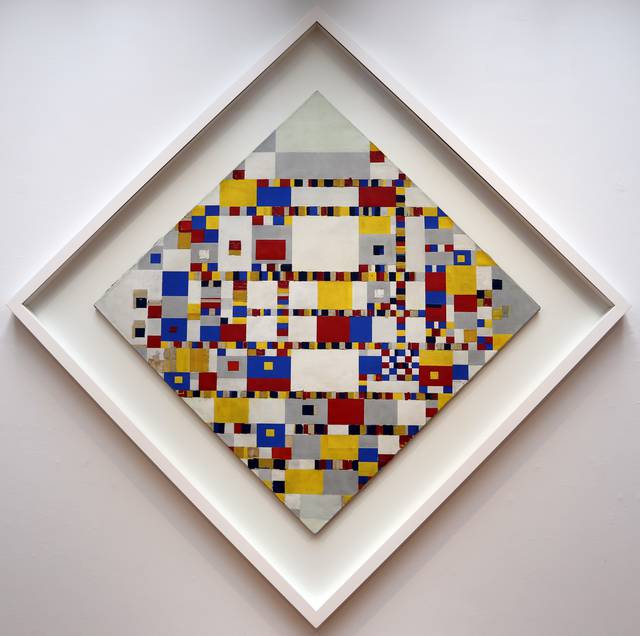 The Statenkwartier area, located between the dunes and the centre, has leafy avenues and 19th century housing and is very popular with The Hague's large expatriate community. The area is nice for walking tours of the 19th-century mansions, which showcase architectural diversity in The Hague. All kinds of neo- and modern-styles are represented here, especially Art Nouveau architecture. Good shops, delicatessens and restaurants are to be found on Statenkwartier's main street, Frederik Hendriklaan, or 'Fred'. The area also has a number of tourist attractions, which make it worth a visit, most of them being clustered around the Gemeentemuseum on Stadhouderslaan.
The Statenkwartier area, located between the dunes and the centre, has leafy avenues and 19th century housing and is very popular with The Hague's large expatriate community. The area is nice for walking tours of the 19th-century mansions, which showcase architectural diversity in The Hague. All kinds of neo- and modern-styles are represented here, especially Art Nouveau architecture. Good shops, delicatessens and restaurants are to be found on Statenkwartier's main street, Frederik Hendriklaan, or 'Fred'. The area also has a number of tourist attractions, which make it worth a visit, most of them being clustered around the Gemeentemuseum on Stadhouderslaan.
- Gemeentemuseum Den Haag, Stadhouderslaan 41 (tram 17 (Statenkwartier stop) or bus 24 (Kijkduin stop), +31 70 3381111. T-Su 11AM-5PM. The Gemeentemuseum (Municipal Museum) has a small collection of classical modern art (Van Gogh, Kandinsky, Monet, Sisley, Degas, Bacon). It boasts an especially large collection of Mondrians, showcasing the entire career of this painter known for his works with red, blue and yellow shapes. The Gemeentemuseum also has a large selection of paintings of the Hague School, a 19th century movement of landscape artists, in addition to period rooms and collections of fashion, musical instruments and decorative arts. Rotating exhibitions on 19th and early 20th century art held here are also quite popular. The museum is housed in a yellow brick building built in 1938 by Dutch architect Hendrik Berlage, a pioneer in modern architecture and best known for his Beurs van Berlage - the exchange building on the Damrak in Amsterdam. Next to the Gemeentemuseum are the GEM, a museum with rotating exhibitions of contemporary art, and the Fotomuseum Den Haag, which has rotating photography exhibitions. €8.
Gemeentemuseum Den Haag, Stadhouderslaan 41 (tram 17 (Statenkwartier stop) or bus 24 (Kijkduin stop), +31 70 3381111. T-Su 11AM-5PM. The Gemeentemuseum (Municipal Museum) has a small collection of classical modern art (Van Gogh, Kandinsky, Monet, Sisley, Degas, Bacon). It boasts an especially large collection of [[De Stijl|Mondrians]], showcasing the entire career of this painter known for his works with red, blue and yellow shapes. The Gemeentemuseum also has a large selection of paintings of the Hague School, a 19th century movement of landscape artists, in addition to period rooms and collections of fashion, musical instruments and decorative arts. Rotating exhibitions on 19th and early 20th century art held here are also quite popular. The museum is housed in a yellow brick building built in 1938 by Dutch architect Hendrik Berlage, a pioneer in modern architecture and best known for his Beurs van Berlage - the exchange building on the Damrak in Amsterdam. Next to the Gemeentemuseum are the GEM, a museum with rotating exhibitions of contemporary art, and the Fotomuseum Den Haag, which has rotating photography exhibitions. €8.
Since The Hague was founded on a former hunting manor, there are a variety of parks and green spaces that are ideal for exploration. Like the majority of cities in the Netherlands, The Hague is extremely bike friendly and it's easy to get from one place to another on a bicycle if you feel like stepping outside the city centre. Scheveningen (and to a lesser extent Kijkduin) is a busy seaside resort filled with boardwalk cafes and close to the dunes. The prime months to get out and see The Hague on foot or by pedal are in the late spring, summer, and early fall months. The beachfront area can get extremely crowded as vacationers from all over Europe come to visit and bask along the North Sea coastline.
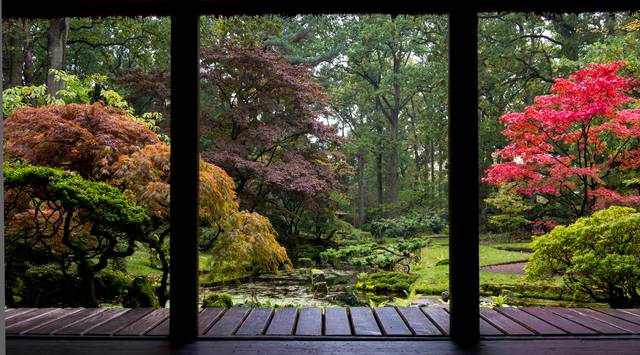
- Park Clingendael. Japanese Garden: late April to mid-June and 2 weeks in mid-October. A part of a former estate, the park is best known for its Japanese garden, one of the oldest (1910) in Europe. While the garden is open only a short period of time, the surrounding area is open all year long. Free admission.
- Westbroekpark. An English-style park from the 1920s. Renowned for its Rosarium or rose garden, with 20,000 different varieties of roses blooming from June until November. The park includes a restaurant with lovely views.
- Haagse Bos. This park is the oldest forested area in the country. It stretches from the suburb of Wassenaar to the northeast and goes right to the doorstep of Centraal Station, where there is a small fenced off area with deer. Haagse Bos also has a large birds-nest built on top of a pole with which the local municipality has succeeded in attracting a pair of storks, since the stork is in the city's emblem. Huis ten Bosch, the King's palace (not open to the public), is located there.
Park Clingendael. Japanese Garden: late April to mid-June and 2 weeks in mid-October. A part of a former estate, the park is best known for its Japanese garden, one of the oldest (1910) in Europe. While the garden is open only a short period of time, the surrounding area is open all year long. Free admission.
Westbroekpark. An English-style park from the 1920s. Renowned for its Rosarium or rose garden, with 20,000 different varieties of roses blooming from June until November. The park includes a restaurant with lovely views.
Haagse Bos. This park is the oldest forested area in the country. It stretches from the suburb of Wassenaar to the northeast and goes right to the doorstep of Centraal Station, where there is a small fenced off area with deer. Haagse Bos also has a large birds-nest built on top of a pole with which the local municipality has succeeded in attracting a pair of storks, since the stork is in the city's emblem. Huis ten Bosch, the King's palace (not open to the public), is located there.
-lMoQr.medium.jpg)
- Museon, Stadhouderslaan 37 (next to the Gemeentemuseum, +31 70 3381338. T-Su 11AM-5PM. An interactive science museum, very popular with school groups and younger crowds. €7.50.
- Omniversum, President Kennedylaan 5 (behind the Museon, +0900-6664837. Cinema with a round screen, offering a 360 degree viewing experience. Runs IMAX/Discovery-style documentaries; some are aimed at children. € 10,75.
- Madurodam, George Maduroplein 1 (tram 9 or 22 (toward Scheveningen Noorderstrand, +31 70 416 2400. 9AM-6PM daily. This miniature city contains a selection of Dutch architecture, ranging from Amsterdam's canals and church spires from Utrecht and Den Bosch, to modern architecture from Rotterdam and the enormous Delta works that protect the country from the sea. Madurodam also has an airport, a seaport, beaches, and little cars, trams and trains running through the entire town. A great attraction for kids (but a tourist trap for adults). Madurodam is open year round. €14.50 for adults, €10.50 for children.
- Watch football, Haags Kwartier 55 (About 5 km east of the centre, 900 m from Station Den Haag Ypenburg. ie soccer at ADO Den Haag, who play in Eredivisie, the top tier of Dutch football. Their home ground is Cars Jeans Stadion, capacity 15,000.
- Duinrell. This amusement park is mainly aimed at children but has accommodation as well for longer stays since it is right near the beach. The surrounding dunes and forested areas are great for walking, cycling and mountain biking.
- Boat trips The Hague, Spui / Zieken. Enjoy The Hague during a boat trip on the canals.
- The North Sea coast resorts. Resort facilities at Scheveningen and at Kijkduin have access to the beach, the dunes, as well as seaside restaurants and cafes. Be sure to check out the Scheveningen Pier, the largest pier in the Netherlands, which has a 60 m (200 ft) lookout tower, bungee jumping, and a casino and restaurant. Scheveningen gets crowded in the summer, so try Kijkduin if you're looking for something a little more peaceful.
Museon, Stadhouderslaan 37 (next to the Gemeentemuseum, +31 70 3381338. T-Su 11AM-5PM. An interactive science museum, very popular with school groups and younger crowds. €7.50.
Omniversum, President Kennedylaan 5 (behind the Museon, +0900-6664837. Cinema with a round screen, offering a 360 degree viewing experience. Runs IMAX/Discovery-style documentaries; some are aimed at children. € 10,75.
Madurodam, George Maduroplein 1 (tram 9 or 22 (toward Scheveningen Noorderstrand, +31 70 416 2400. 9AM-6PM daily. This miniature city contains a selection of Dutch architecture, ranging from Amsterdam's canals and church spires from Utrecht and Den Bosch, to modern architecture from Rotterdam and the enormous Delta works that protect the country from the sea. Madurodam also has an airport, a seaport, beaches, and little cars, trams and trains running through the entire town. A great attraction for kids (but a tourist trap for adults). Madurodam is open year round. €14.50 for adults, €10.50 for children.
Watch football, Haags Kwartier 55 (About 5 km east of the centre, 900 m from Station Den Haag Ypenburg. ie soccer at ADO Den Haag, who play in Eredivisie, the top tier of Dutch football. Their home ground is Cars Jeans Stadion, capacity 15,000.
Duinrell. This amusement park is mainly aimed at children but has accommodation as well for longer stays since it is right near the beach. The surrounding dunes and forested areas are great for walking, cycling and mountain biking.
Boat trips The Hague, Spui / Zieken. Enjoy The Hague during a boat trip on the canals.
The North Sea coast resorts. Resort facilities at Scheveningen and at Kijkduin have access to the beach, the dunes, as well as seaside restaurants and cafes. Be sure to check out the Scheveningen Pier, the largest pier in the Netherlands, which has a 60 m (200 ft) lookout tower, bungee jumping, and a casino and restaurant. Scheveningen gets crowded in the summer, so try Kijkduin if you're looking for something a little more peaceful.
- Life I Live Festival. Evening of the 26th of April. While Amsterdam is generally known for having country's largest celebration of Dutch King's Day on the 27th of April, in recent years The Hague has held the largest anticipatory party the night before. KoningsNach (Kings' Night in The Hague dialect) has bands and DJ's giving shows in 5 different locations in the city centre.
- Parkpop. Last Sunday of June. Huge, free, one-day pop music festival held in Zuiderpark. Attracts nearly 400.000 visitors each year, nearly as many people as actually live in the city, making the festival the largest of its kind in the world.
- Tong Tong Fair. End of May/beginning of June. This claims to be the largest Eurasian festival in the world. Since its first edition in 1958 it has been the quintessential event and meeting place for the country's sizable Dutch-East-Indian community. The festival also attracts lots of outsiders though, who come to sample Indonesian cuisine in the huge food halls, listen to music, buy foodstuffs, Indonesian clothes and paraphernalia and inform themselves about Indonesian culture. The festival is held in large tents on the Malieveld, opposite Centraal.
- Den Haag Sculptuur. June, July and August. Free sculpture exposition on Lange Voorhout with different themes each year.
- Prinsjesdag. Third Tuesday in September. Prinsjesdag or 'Princes Day' marks the beginning of the new parliamentary year. On this day, large crowds are drawn by the traditional journey that King Willem-Alexander makes from his palace at Noordeinde to the Knight's Hall at the Binnenhof. He makes the trip in the Gouden Koets (Golden Carriage), a gift from the people of Amsterdam to his great-grandmother Wilhelmina from 1903. The carriage is used only for this special occasion. However the Gouden koets undergoes a restoration and is replaced by the Glazen Koets (Glass Carriage) during the years 2016-2019. In the Knight's Hall, the King then performs his duty as the formal head of state by reading out the Troonrede (Throne Speech) to the gathered chambers of the parliament. The throne speech contains a summary of the policies the cabinet is planning to implement over the next year.
- Crossing Border Festival. November.
- TodaysArt Festival. Last weekend of September. International Festival Beyond Art.
Life I Live Festival. Evening of the 26th of April. While Amsterdam is generally known for having country's largest celebration of Dutch King's Day on the 27th of April, in recent years The Hague has held the largest anticipatory party the night before. KoningsNach (Kings' Night in The Hague dialect) has bands and DJ's giving shows in 5 different locations in the city centre.
Parkpop. Last Sunday of June. Huge, free, one-day pop music festival held in Zuiderpark. Attracts nearly 400.000 visitors each year, nearly as many people as actually live in the city, making the festival the largest of its kind in the world.
Tong Tong Fair. End of May/beginning of June. This claims to be the largest Eurasian festival in the world. Since its first edition in 1958 it has been the quintessential event and meeting place for the country's sizable Dutch-East-Indian community. The festival also attracts lots of outsiders though, who come to sample Indonesian cuisine in the huge food halls, listen to music, buy foodstuffs, Indonesian clothes and paraphernalia and inform themselves about Indonesian culture. The festival is held in large tents on the Malieveld, opposite Centraal.
Den Haag Sculptuur. June, July and August. Free sculpture exposition on Lange Voorhout with different themes each year.
Prinsjesdag. Third Tuesday in September. Prinsjesdag or 'Princes Day' marks the beginning of the new parliamentary year. On this day, large crowds are drawn by the traditional journey that King Willem-Alexander makes from his palace at Noordeinde to the Knight's Hall at the Binnenhof. He makes the trip in the Gouden Koets (Golden Carriage), a gift from the people of Amsterdam to his great-grandmother Wilhelmina from 1903. The carriage is used only for this special occasion. However the Gouden koets undergoes a restoration and is replaced by the Glazen Koets (Glass Carriage) during the years 2016-2019. In the Knight's Hall, the King then performs his duty as the formal head of state by reading out the Troonrede (Throne Speech) to the gathered chambers of the parliament. The throne speech contains a summary of the policies the cabinet is planning to implement over the next year.
Crossing Border Festival. November.
TodaysArt Festival. Last weekend of September. International Festival Beyond Art.
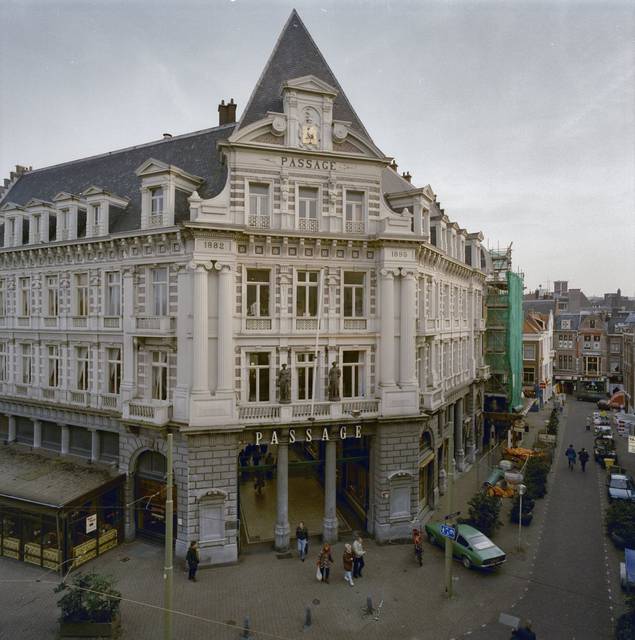
The lively and historical centre of The Hague is perfect for a day of shopping. The shopping area around the Spuistraat and Grote Marktstraat is busy seven days a week. You can find the best shopping in The Hague on the side streets that circle out from the city centre. While lots of them are upscale, you can find a few bargain stores dotted here and there.
- De Bijenkorf, Wagenstraat 32 (corner of Grote Marktstraat. The only extant department store in The Hague is housed in a large building from 1924, built in a unique expressionist style with brick and copper. Have a look at the glass-stained windows in the staircase. The restaurant 'La Ruche' in the third floor has a good view of the surrounding area.
- De Passage. A unique covered shopping gallery built in 1882, with a sister-building in Brussels. Here you can find specialty and upmarket fashion shopping. Check out the outdoor cafes just outside on Buitenhof.
- Snoeptrommel winkels. This building is near the up-market Hoogstraat shopping area. Locals call it "The Candy Box" because of its unique exterior. Completed in 2000, it's one of the newer building in the city
- The American Book Center, Lange Poten 23, +31 70 3642742. This unique store sells new and used English titles and caters to both expats and locals. If you're dragging extra copies of books across Europe, but don't want to throw them away, try trading them in here.
- Prinsestraat. Specialty shops, delicatessens and restaurants in the area around this street, located between Grote Kerk and Noordeinde palace.
- Spuistraat. Pedestrianized, shopping streets with mainly small chain stores. Other streets bordering the area with similar shops are Vlamingstraat, Venestraat and Wagenstraat.
- Denneweg and Noordeinde. These shopping streets lie parallel to one another from either side of the Binnenhof. The former has antiques, bric-à-brac, and several interesting restaurants and specialty food shops, while the latter is known for its boutiques and haute couture.
De Bijenkorf, Wagenstraat 32 (corner of Grote Marktstraat. The only extant department store in The Hague is housed in a large building from 1924, built in a unique expressionist style with brick and copper. Have a look at the glass-stained windows in the staircase. The restaurant 'La Ruche' in the third floor has a good view of the surrounding area.
De Passage. A unique covered shopping gallery built in 1882, with a sister-building in Brussels. Here you can find specialty and upmarket fashion shopping. Check out the outdoor cafes just outside on Buitenhof.
Snoeptrommel winkels. This building is near the up-market Hoogstraat shopping area. Locals call it "The Candy Box" because of its unique exterior. Completed in 2000, it's one of the newer building in the city
The American Book Center, Lange Poten 23, +31 70 3642742. This unique store sells new and used English titles and caters to both expats and locals. If you're dragging extra copies of books across Europe, but don't want to throw them away, try trading them in here.
Prinsestraat. Specialty shops, delicatessens and restaurants in the area around this street, located between Grote Kerk and Noordeinde palace.
Spuistraat. Pedestrianized, shopping streets with mainly small chain stores. Other streets bordering the area with similar shops are Vlamingstraat, Venestraat and Wagenstraat.
Denneweg and Noordeinde. These shopping streets lie parallel to one another from either side of the Binnenhof. The former has antiques, bric-à-brac, and several interesting restaurants and specialty food shops, while the latter is known for its boutiques and haute couture.
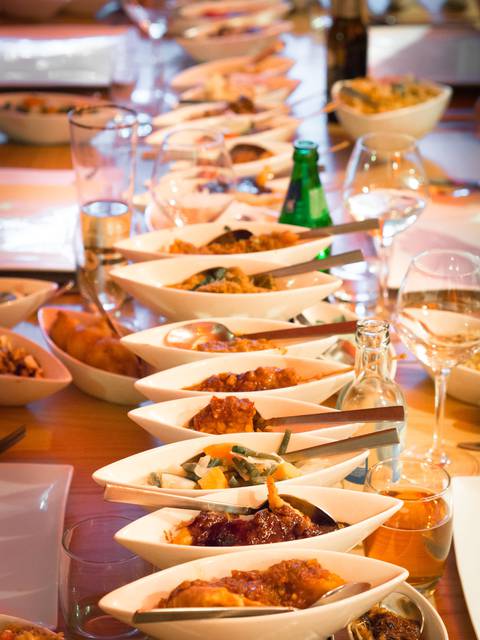 Just as Indian restaurants abound in the UK, the Netherlands has an excellent tradition in Indonesian and colonial Dutch-Indies cuisine. After Indonesia became independent from the Netherlands in 1945, the country received a large number of former colonials from Dutch and mixed descent who had been forced to leave the newly independent colony. The Hague received a relatively large number of these people and is still a centre of the Dutch-Indonesian community.
Just as Indian restaurants abound in the UK, the Netherlands has an excellent tradition in Indonesian and colonial Dutch-Indies cuisine. After Indonesia became independent from the Netherlands in 1945, the country received a large number of former colonials from Dutch and mixed descent who had been forced to leave the newly independent colony. The Hague received a relatively large number of these people and is still a centre of the Dutch-Indonesian community.
- Haagsche brood- en banketbakkerij Hans en Frans, Denneweg 128. 07.00 - 17.00. Famous local bakery. Try their Haagse Kakker, which is a big sweet bread filled with raisins and nuts. Great to bring home as a gift. Other specialties include Haagsche Ooievaartjes (cookies) and Haags Jantje (chocolate). They are also located at Theresiastraat 131 and Reinkenstraat 50
- Restaurant Alexander The Hague, Denneweg 138 2514 CL, +31 70 36 48 175. 17:00 - 23:00. 3 course menu € 27.50 per person.
- Burgerz, Prinsestraat 23, +31 70 3560062. Funky gourmet hamburger restaurant serving 25 home-made and pure burgers: beef, lamb chicken, salmon, tuna and vegetarian. Also for take-away and from sept 2011 also in Delft.
- 't Achterommetje, Achterom, 71 (across the parliament. A nice place for a standard Dutch lunch or a coffee.
- Garoeda, Kneuterdijk 18 A, +31 70 3648175. Historic place (founded 1949) with waiters in traditional costumes, spread out over two floors.
- Poentjak, Kneuterdijk 16, +31 70 3600522. Next to Garoeda. Interior is a time-warp to the 1920s. ~€20 for dinner.
- Istana, Wagenstraat 71, +31 70 3600997. Small restaurant with somewhat minimalist decor. Excellent sateh.
Garoeda, Kneuterdijk 18 A, +31 70 3648175. Historic place (founded 1949) with waiters in traditional costumes, spread out over two floors.
Poentjak, Kneuterdijk 16, +31 70 3600522. Next to Garoeda. Interior is a time-warp to the 1920s. ~€20 for dinner.
Istana, Wagenstraat 71, +31 70 3600997. Small restaurant with somewhat minimalist decor. Excellent sateh.
- Bogor, Van Swietenstraat 2, +31 70 3461628. Known by the in-crowd as traditionally the best place in town. Simple but excellent food, has been around for over 40 years and has not changed.
- Palembang, Thomsonlaan 17, +31 70 3653881. Cosy place with excellent food. Lots of pictures on the wall with local celebrities who visited here.
- Keraton Damai, Groot Hertoginnelaan 57, +31 70 3639371. Small 'living-room style restaurant' with very personal and attentive service. Small but excellent choice of dishes.
- Isaku Iki, Anna Paulownastraat 17, +31 70 3920033. This place has restaurant area and take-away service.
Bogor, Van Swietenstraat 2, +31 70 3461628. Known by the in-crowd as traditionally the best place in town. Simple but excellent food, has been around for over 40 years and has not changed.
Palembang, Thomsonlaan 17, +31 70 3653881. Cosy place with excellent food. Lots of pictures on the wall with local celebrities who visited here.
Keraton Damai, Groot Hertoginnelaan 57, +31 70 3639371. Small 'living-room style restaurant' with very personal and attentive service. Small but excellent choice of dishes.
Isaku Iki, Anna Paulownastraat 17, +31 70 3920033. This place has restaurant area and take-away service.
- Hanting Cuisine, Prinsestraat 33, +31 70 3620828. Chef Han merges Oriental and French cuisines. Han uses famous ingredients from both worlds and combines traditional preparation methods and techniques.
- Calla's, Laan van Roos en Doorn 51A, +31 70 3455866. Modern and with painstaking preparation techniques. Shorter, concentration on cuisson, light sauces and rich in taste. Food at Calla's is in the classical French tradition stripped of all frills and furbelows.
Hanting Cuisine, Prinsestraat 33, +31 70 3620828. Chef Han merges Oriental and French cuisines. Han uses famous ingredients from both worlds and combines traditional preparation methods and techniques.
Calla's, Laan van Roos en Doorn 51A, +31 70 3455866. Modern and with painstaking preparation techniques. Shorter, concentration on cuisson, light sauces and rich in taste. Food at Calla's is in the classical French tradition stripped of all frills and furbelows.
- Baklust, Veenkade 19, +31 70 7532274. 10.00-18.00 th/su. Run by ex-squatters, Baklust is an organic and vegetarian cafe with an international air.
- Water & Brood, Hellingweg 127, +31 70 3997455. An ex-squat, organic and vegetarian diner.
Baklust, Veenkade 19, +31 70 7532274. 10.00-18.00 th/su. Run by ex-squatters, Baklust is an organic and vegetarian cafe with an international air.
Water & Brood, Hellingweg 127, +31 70 3997455. An ex-squat, organic and vegetarian diner.
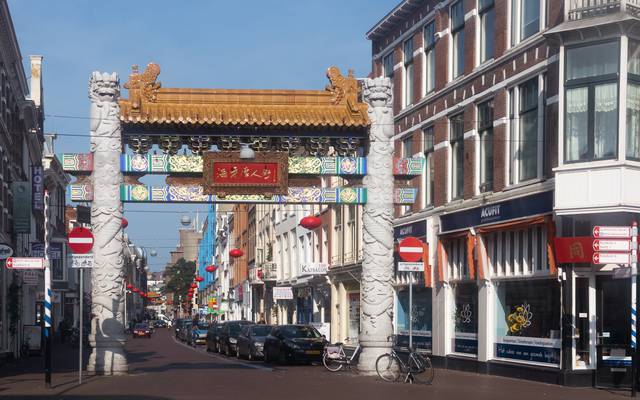
- NOH Sushi & Sake, Prinsestraat 77 (next to 'de Paleistuinen' or take tram 17 and get out at 'Noordwal', +31 70 3633320. Kitchen open: Wednesday - Sunday: 17.30- 22.30 Monday and Tuesday: Closed. NOH is one of the most relaxing and finest Japanese sushi restaurants in The Hague, providing all the basics for an enjoyable evening. They regularly serve Toro and Uni and have a sushibar for single (travelling) people. €33.
- Kiraku, Toussaintkade 31, +31 70 3454288. Open since 1992. It's a small restaurant with a sushibar, the sushi taste excellent so make a reservation or come in early for dinner
- Dudok, Hofweg 1a, +31 70 8900100. Dudok lies right opposite the Binnenhof and is quite popular with politicians and the public out shopping.
- Irodion, Grote Markt 19, +31 70 3636623. Greek restaurant in the city centre. It is made up of two restaurants; the first one is fast food take out, where you can get the ubiquitous giros and tzatziki, with a generous portion of French fries. The second part is a fancier eat-in restaurant. Highly recommended.
- Bodega de Posthoorn, Lange Voorhout 39A, +31 70 3604906. A grand cafe at the centre of The Hague, near tourist attractions such as Maurtishuis, Hofvijver, Binnenhof, Historical Museum and Escher Museum. It is a unique eating and drinking establishment with typical Dutch grandeur. You should at least have a cup of coffee here, to experience the grandeur.
- Florencia Ice, Torenstraat 44, +31 70 3630214. Near the Grote Kerk the best ice cream parlor in town.
- Chinatown. The town has dubbed the area around Gedempte Gracht, Gedempte Burgwal and Wagenstraat as its local Chinatown, and added street signs in Chinese and all that. The area is not particularly spectacular, but good Chinese food is to be found around here. There seem to be three real popular Chinese restaurants in 'Chinatown'. Two of these restaurant have the same owner, but the restaurants are quite different. There is Fat Kee (preferred by Indian, Dutch and people from Suriname), which has a superb chicken and broccoli dish, though most 'local' Chinese people seem to go to the restaurants Kee Lun Palace and Restaurant Long Ting. Both have really good Chinese food for a relatively low price, though the service is generally rated below average. Another reasonable place is Harvest, which is in the heart of Chinatown; it's usually visited by Dutch people and Chinese people seem somehow to avoid it.
- Rebelz, Junostraat 127 2516 BR, +3170-216 17 98. €17 you have a good meal.
NOH Sushi & Sake, Prinsestraat 77 (next to 'de Paleistuinen' or take tram 17 and get out at 'Noordwal', +31 70 3633320. Kitchen open: Wednesday - Sunday: 17.30- 22.30 Monday and Tuesday: Closed. NOH is one of the most relaxing and finest Japanese sushi restaurants in The Hague, providing all the basics for an enjoyable evening. They regularly serve Toro and Uni and have a sushibar for single (travelling) people. €33.
Kiraku, Toussaintkade 31, +31 70 3454288. Open since 1992. It's a small restaurant with a sushibar, the sushi taste excellent so make a reservation or come in early for dinner
Dudok, Hofweg 1a, +31 70 8900100. Dudok lies right opposite the Binnenhof and is quite popular with politicians and the public out shopping.
Irodion, Grote Markt 19, +31 70 3636623. Greek restaurant in the city centre. It is made up of two restaurants; the first one is fast food take out, where you can get the ubiquitous giros and tzatziki, with a generous portion of French fries. The second part is a fancier eat-in restaurant. Highly recommended.
Bodega de Posthoorn, Lange Voorhout 39A, +31 70 3604906. A grand cafe at the centre of The Hague, near tourist attractions such as Maurtishuis, Hofvijver, Binnenhof, Historical Museum and Escher Museum. It is a unique eating and drinking establishment with typical Dutch grandeur. You should at least have a cup of coffee here, to experience the grandeur.
Florencia Ice, Torenstraat 44, +31 70 3630214. Near the Grote Kerk the best ice cream parlor in town.
Chinatown. The town has dubbed the area around Gedempte Gracht, Gedempte Burgwal and Wagenstraat as its local Chinatown, and added street signs in Chinese and all that. The area is not particularly spectacular, but good Chinese food is to be found around here. There seem to be three real popular Chinese restaurants in 'Chinatown'. Two of these restaurant have the same owner, but the restaurants are quite different. There is Fat Kee (preferred by Indian, Dutch and people from Suriname), which has a superb chicken and broccoli dish, though most 'local' Chinese people seem to go to the restaurants Kee Lun Palace and Restaurant Long Ting. Both have really good Chinese food for a relatively low price, though the service is generally rated below average. Another reasonable place is Harvest, which is in the heart of Chinatown; it's usually visited by Dutch people and Chinese people seem somehow to avoid it.
Rebelz, Junostraat 127 2516 BR, +3170-216 17 98. €17 you have a good meal.
Haagsche brood- en banketbakkerij Hans en Frans, Denneweg 128. 07.00 - 17.00. Famous local bakery. Try their Haagse Kakker, which is a big sweet bread filled with raisins and nuts. Great to bring home as a gift. Other specialties include Haagsche Ooievaartjes (cookies) and Haags Jantje (chocolate). They are also located at Theresiastraat 131 and Reinkenstraat 50
Restaurant Alexander The Hague, Denneweg 138 2514 CL, +31 70 36 48 175. 17:00 - 23:00. 3 course menu € 27.50 per person.
Burgerz, Prinsestraat 23, +31 70 3560062. Funky gourmet hamburger restaurant serving 25 home-made and pure burgers: beef, lamb chicken, salmon, tuna and vegetarian. Also for take-away and from sept 2011 also in Delft.
't Achterommetje, Achterom, 71 (across the parliament. A nice place for a standard Dutch lunch or a coffee.
- De Grote Markt. Su M Tu W 10AM-1AM; Th F Sa 10AM-1:30AM. Throughout the centuries the market square of The Hague has transformed into a grand outdoor café surrounded by bars and clubs. From early in the morning, until late at night you’ll find people having a good time here. In the summertime, the ‘Grote Markt’ is often home to musical events.
* Boterwaag. Opposite September, housed in a former weighing building it's a spacious and atmospheric venue. The Boterwaag is a wheelchair-accessible cafe.
* September. Locate next to De Zwarte Ruiter.
* Supermarkt. W 9PM-1AM; Th F Sa 9PM-3AM. A bar cum live rock venue, next to September and De Zwarte Ruiter.
* VaVoom Tikiroom. alternative, surf style bar run by tattooed people
* Zeta, Grote Markt 28. Located between De Zwarte Ruiter and VaVoom Tikiroom.
* Zwarte Ruiter, Grote Markt 27. Located between Zeta and Supermarkt.
- 27 Club, Achterom 8, +31 6 48104541. Named after artists who died 27 years old, among who Brian Jones, Kurt Cobain, Janis Joplin and Amy Winehouse.
- Cafe Momfer de Mol, Oude Molstraat 19, +31 70 4278733. Cafe Momfer de Mol is located in the centre of the old Hague a place steeped in history. The cafe in its present form has been in existence since 2003, and is one of the finest laid-back cafe-bars of the city. The warm interiors and the informal ambiance at the cafe, are ideal allies to its delightful snack menu.
- Cafe Madeleine, Valkenbosplein 10, +31 70 3630609. 08 am. Just outside the centre. Take tram 3 to Valkenbosplein and have a coffee and something sweet.
De Grote Markt. Su M Tu W 10AM-1AM; Th F Sa 10AM-1:30AM. Throughout the centuries the market square of The Hague has transformed into a grand outdoor café surrounded by bars and clubs. From early in the morning, until late at night you’ll find people having a good time here. In the summertime, the ‘Grote Markt’ is often home to musical events.
27 Club, Achterom 8, +31 6 48104541. Named after artists who died 27 years old, among who Brian Jones, Kurt Cobain, Janis Joplin and Amy Winehouse.
Cafe Momfer de Mol, Oude Molstraat 19, +31 70 4278733. Cafe Momfer de Mol is located in the centre of the old Hague a place steeped in history. The cafe in its present form has been in existence since 2003, and is one of the finest laid-back cafe-bars of the city. The warm interiors and the informal ambiance at the cafe, are ideal allies to its delightful snack menu.
Cafe Madeleine, Valkenbosplein 10, +31 70 3630609. 08 am. Just outside the centre. Take tram 3 to Valkenbosplein and have a coffee and something sweet.
As everywhere in the Netherlands, the possession (of small quantities) and use of cannabis (hash and weed) is tolerated in The Hague. Since Amsterdam draws more coffee-shop tourism prices are lower in The Hague. Some renowned places:
- Cafe Cremers, Prinsestraat 84. A great pub and coffeeshop with great DJs. The one place where international visitors gather to smoke and drink. Don't miss it.
- Ceylon, Edisonstraat 98.
- Fly High, Rijswijkseweg 229.
- Seventh Planet, Loosduinseweg 741.
Possessing large quantities of hashish or cannabis is a crime in the Netherlands. Do not take stuff with you when leaving the Netherlands (you can be punished severely in neighbouring countries). It's also unwise to buy for someone else, especially if it's a foreigner as you can be punished in his or her country of origin.
Smoking tobacco is banned inside food and drink establishments — even coffeeshops! That being said, tobacco smoking appears to be tolerated in coffee shops, and their rolled joints are often mixed with tobacco.
Cafe Cremers, Prinsestraat 84. A great pub and coffeeshop with great DJs. The one place where international visitors gather to smoke and drink. Don't miss it.
Ceylon, Edisonstraat 98.
Fly High, Rijswijkseweg 229.
Seventh Planet, Loosduinseweg 741.
- Paard van Troje and Paard Café. Also a venue for concerts and such. Prinsegracht 12.
Paard van Troje and Paard Café. Also a venue for concerts and such. Prinsegracht 12.
You should take normal precautions against pickpockets and baggage theft, especially in the main shopping streets, in trams and trains, at stations, and anywhere where tourists congregate. Street begging is common around the Hollands Spoor train station and at the Grote Markt. Most of them are homeless and non-aggressive and a simple 'no' will be enough. At night, the city centre is quite safe because of the large number of police cameras monitoring this area. Neighbourhoods southwest of the centre are less affluent and may not be as safe. The area between Zuiderpark and Hollands Spoor has a bad reputation due to the increasing number of street gangs. Schilderswijk and Transvaal areas are blocks that should be avoided after dark. If you are unsure, take a taxi to your destination. Taking a tram is also considered safe, as the so-called 'risky lines' in this area now have a security team on board from 8PM till 1AM.
|
|
Quaint cities like Delft, known for its famous blue pottery, and the university town of Leiden are just 15 minutes by train.
- Scheveningen - Closest sea resort to the city.
- Delft - Arguably the country's most picturesque canal-lined town. Home of the famous Delft Blue pottery (or Delftware), and the home of Baroque painter Johannes Vermeer. Trains leave from Centraal Station or Hollands Spoor every 15 min; the trip takes 12 or 8 min respectively. Tram 1 also reaches the Delft city centre.
- Leiden - This town lays claim to the oldest university in the Netherlands, Leiden University, which was founded in 1575. It is the second largest 17th-century town centre after Amsterdam. Home to many interesting museums. Trains from Centraal Station or Hollands Spoor every 15 minutes, with each trip taking 13 or 10 minutes respectively.
[[Scheveningen]] - Closest sea resort to the city.
[[Delft]] - Arguably the country's most picturesque canal-lined town. Home of the famous Delft Blue pottery (or Delftware), and the home of Baroque painter Johannes Vermeer. Trains leave from Centraal Station or Hollands Spoor every 15 min; the trip takes 12 or 8 min respectively. Tram 1 also reaches the Delft city centre.
[[Leiden]] - This town lays claim to the oldest university in the Netherlands, Leiden University, which was founded in 1575. It is the second largest 17th-century town centre after Amsterdam. Home to many interesting museums. Trains from Centraal Station or Hollands Spoor every 15 minutes, with each trip taking 13 or 10 minutes respectively.
